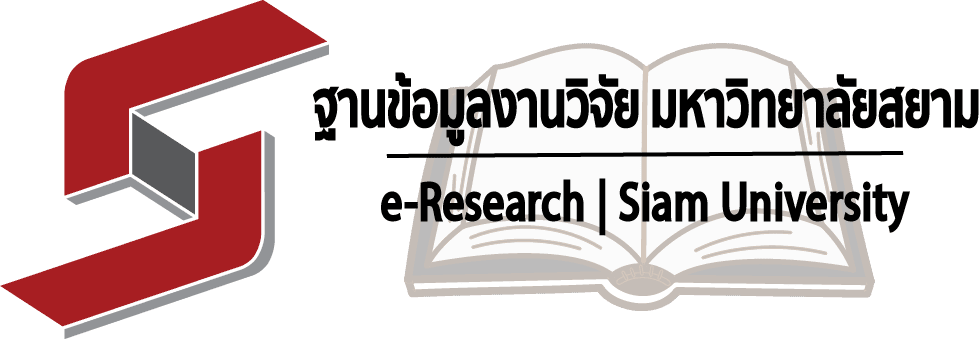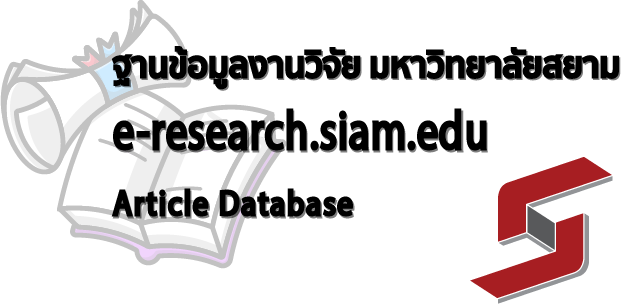- KB Home
- หลักสูตรระดับบัณฑิตศึกษา|Graduate Schools
- หลักสูตรปริญญาเอก|Doctoral Degree
- Ph.D. Ed
- รูปแบบการพัฒนาครูของมหาวิทยาลัยราชภัฏ
| หัวข้อวิทยานิพนธ์: Project Title: |
รูปแบบการพัฒนาครูของมหาวิทยาลัยราชภัฏ The Rajabhat model of teacher’s professional development |
| ชื่อนักศึกษา: Author: |
นางสาววรรณภร ศิริพละ Miss Wannaporn Siripala |
| อาจารย์ที่ปรึกษา: Advisor: |
รองศาสตราจารย์ ดร.จอมพงศ์ มงคลวนิช, ดร.จักรพรรดิ วะทา Associate Professor Dr.Jomphong Mongkhonvanit, Dr.Jakraphat Watha |
| ระดับการศึกษา: Degree: |
ปรัชญาดุษฎีบัณฑิต (ปร.ด.) Doctor of Philosophy |
| สาขาวิชา: Major: |
ภาวะผู้นำและนวัตกรรมการบริหารการศึกษา Leadership and Innovation in Educational Administration |
| คณะ: Faculty: |
บัณฑิตวิทยาลัย Graduate Schools |
| ปีการศึกษา: Academic year: |
2559 2016 |
การอ้างอิง/citation
วรรณภร ศิริพละ. (2559). รูปแบบการพัฒนาครูของมหาวิทยาลัยราชภัฏ. (วิทยานิพนธ์ปรัชญาดุษฎีบัณฑิต). กรุงเทพฯ: บัณฑิตวิทยาลัย มหาวิทยาลัยสยาม.
บทคัดย่อ
การวิจัยครั้งนี้มีวัตถุประสงค์ (1) เพื่อศึกษาสภาพปัจจุบันการพัฒนาครูของมหาวิทยาลัย ราชภัฏ (2) พัฒนารูปแบบการพัฒนาครูของมหาวิทยาลัยราชภัฏ ระเบียบวิธีที่ใช้ในการวิจัย คือ การสํารวจ และการสัมภาษณ์เชิงลึก กลุ่มตัวอย่าง ได้แก่ 1) คณาจารย์และผู้บริหารของมหาวิทยาลัย ราชภัฏ และ 2) ครูในสถานศึกษาสังกัดสํานักงานคณะกรรมการการศึกษาขั้นพื้นฐาน และสังกัด สํานักการศึกษากรุงเทพมหานคร เครื่องมือที่ใช้ในการวิจัย คือ แบบสอบถามมาตรวัดประมาณค่า 5 ระดับ และแบบสัมภาษณ์ วิเคราะห์ข้อมูลด้วยสถิติเชิงพรรณนา และสมการการถดถอยเชิงพหุ
ผลการวิจัยพบว่า
1. สภาพปัจจุบันการพัฒนาครูของมหาวิทยาลัยราชภัฏ คือ 1) รูปแบบการพัฒนาครู ได้แก่ ปัจจัยนําเข้า ประกอบด้วย หลักสูตร บุคลากร งบประมาณ อุปกรณ์ เทคโนโลยีและการบริหารงาน กระบวนการ ประกอบด้วย วางแผน ลงมือปฏิบัติ ประเมินผลและตรวจสอบ ผลผลิต ประกอบด้วย วุฒิการศึกษาหรือวิทยฐานะเพิ่มขึ้น เทคนิคการจัดการเรียนรู้และวิจัยในชั้นเรียน ผลสะท้อนกลับ ประกอบด้วย ความร่วมมือระหว่างมหาวิทยาลัยราชภัฏกับสถานศึกษาระดับการศึกษาขั้นพื้นฐาน ทุกปัจจัยมีผลการดําเนินงานระดับมาก ด้วยค่าเฉลี่ย 3.86, 3.81, 3.86 และ 3.87 ตามลําดับ ส่วน เบี่ยงเบนมาตรฐาน 0.91, 0.90, 0.86 และ 0.85 ตามลําดับ และ 2) ความพึงพอใจของครูระคับ การศึกษาขั้นพื้นฐานต่อการพัฒนาครูของมหาวิทยาลัยราชภัฏได้แก่ ปัจจัยนําเข้า ประกอบด้วย สํารวจความต้องการพัฒนาของครู หลักสูตร สถานที่พัฒนาครู กระบวนการ ประกอบด้วย กิจกรรม สร้างทัศนคติทางบวกและเสริมแรงทางบวกกับผู้รับการพัฒนา อบรม ร่วมนิเทศ ติดตามผล ผลผลิต ประกอบด้วย ครูพึงพอใจต่อการพัฒนาและศึกษาค้นคว้าด้วยตนเอง มีวุฒิการศึกษาหรือวิทยฐานะเพิ่มขึ้น สถานศึกษาพัฒนาอย่างต่อเนื่อง ผลสะท้อนกลับ ประกอบด้วย ครูมีแรงจูงใจพัฒนาตนเอง ทุกปัจจัยมีความพึงพอใจระดับมาก ค่าเฉลี่ย 4.02, 4.09, 4.17 และ 4.14 ตามลําดับ ส่วนเบี่ยงเบน มาตรฐาน 0.75, 0.78, 0.79 และ 0.74 ตามลําดับ
2. รูปแบบการพัฒนาครูของมหาวิทยาลัยราชภัฏจากการวิจัย ได้แก่ 1) ปัจจัยนําเข้า ประกอบด้วย หน่วยงานรับผิดชอบ หลักสูตรพัฒนาครูตามความต้องการของครูและนโยบายของ หน่วยงานต้นสังกัด ผู้มีความจําเป็นต้องได้รับการพัฒนา 2) กระบวนการพัฒนาครู ประกอบด้วย นวัตกรรมใหม่ตามบริบทของมหาวิทยาลัยราชภัฏ ส่งเสริมการสร้างบทเรียนบนระบบการศึกษา แบบเปิดเพื่อการเรียนรู้ตลอดชีวิต (Thai Massive Open Online Course: Thai Mooc) เน้นการชี้แนะ (Coaching) และติดตามผลที่สถานศึกษา 3) ผลผลิต เน้นผลที่สอดคล้องความต้องการของ ผู้รับบริการเชิงวิชาการ 4) ผลสะท้อนกลับ ประกอบด้วย การสร้างความร่วมมือระหว่างมหาวิทยาลัย ราชภัฏและสถานศึกษา แรงจูงใจการพัฒนาตนเองอย่างสม่ําเสมอ ส่งเสริมให้เกิดชุมชนการเรียนรู้ ทางวิชาชีพในสถานศึกษา (PLC – Professional Learning Community) และ5) บริบท ประกอบด้วย ทักษะการคิด ทักษะทางเทคโนโลยีสารสนเทศและทักษะทางภาษา
กระบวนการพัฒนาครูของมหาวิทยาลัยราชภัฏจากการวิจัย คือ 1) จัดทําสารสนเทศ จากผลสํารวจความต้องการของผู้รับบริการ และ 2) จัดทําแผนพัฒนาและหลักสูตรพัฒนาครู 3) ดําเนินการพัฒนาตามที่กําหนด ตลอดจนสร้างทัศนคติที่ดีต่อการพัฒนาตนเองและการวิจัยใน ชั้นเรียน 4) กํากับ ติดตาม ประเมินผลการพัฒนา ทั้งด้านความรู้ และจิตพิสัย
Abstract
This purpose of the research aimed (1) to study the current situation of teacher development of Rajabhat Universities; and (2) to develop the Rajabhat Model of professional development of teachers. The research methodology involved survey and in-depth interview. Two groups of sample were obtained: 1) the faculties and executives of Rajabhat Universities and 2) teachers from schools under the Office of the Basic Education Commission and under Department of Education of Bangkok Metropolitan Administration. Research instruments were five-point rating scale questionnaires and interview. Descriptive statistics and multiple regression were used in data analysis.
The result showed
1. The current condition of Rajabhat Universities teacher development was the following. 1) Input (curriculum, personnel, budget, materials, technology and administration), process (planning, doing, checking and acting), output (educational qualifications or higher academic ranks, and learning management techniques and classroom action research), feedback (the cooperation between Rajabhat Universities and schools under the Office of the Basic Education Commission) were assessed at the ‘High level shown through the mean at 3.86, 3.81, 3.86 and 3.87; and standard deviation at 0.91, 0.90, 0.86 and 0.85 respectively. 2) The satisfaction of the teachers from the schools under the Office of the Basic Education Commission towards teacher development of Rajabhat Universities was assessed in terms of input (survey of needs in teachers’ development, curriculum and institution), process (positive thinking and reinforcement activities, co-supervision and monitoring), output (self-directed learning, higher educational qualifications or academic ranks, and continual development of institutes), and feedback (motivation in self-development) were assessed at the ‘High’ level shown through the mean at 4.02, 4.09, 4.17 and 4.14; and the were mean standard deviation at 0.75, 0.78, 0.79 and 0.74 respectively.
2. The Rajabhat Model of Teachers’ Professional Development was presented as follows.
1) Input: department in charge, teacher development program in compliance with teachers’ need and their affiliations policy, and the target group; 2) Process: the innovation after the Rajabhat Universities’ context, promotion of Thai Massive Open Online Course: (Thai Mooc) based on coaching and monitoring; 3) Output: emphasis on the products in line with the academic service users’ need; 4) Feedback: building up the cooperation between Rajabhat Universities and Schools, motivation in continuous self-development, promotion of PLC – Professional Learning Community; and 5) Context: thinking skills, IT skills, and language skills.
The process of teacher development was presented as follows. 1) Development and analysis of the information from the survey of service users’ need; 2) Development of improvement plan and teacher development curriculum; 3) Implementation of such a plan and curriculum, including promotion of position attitude towards self-development and classroom action research; and 4) Monitoring and assessing the teachers’ development of knowledge and affective domain.
รูปแบบการพัฒนาครูของมหาวิทยาลัยราชภัฏ|The Rajabhat model of teacher’s professional development
Doctor of Philosophy in Leadership and Innovation in Educational Administration, Siam University, Thailand


